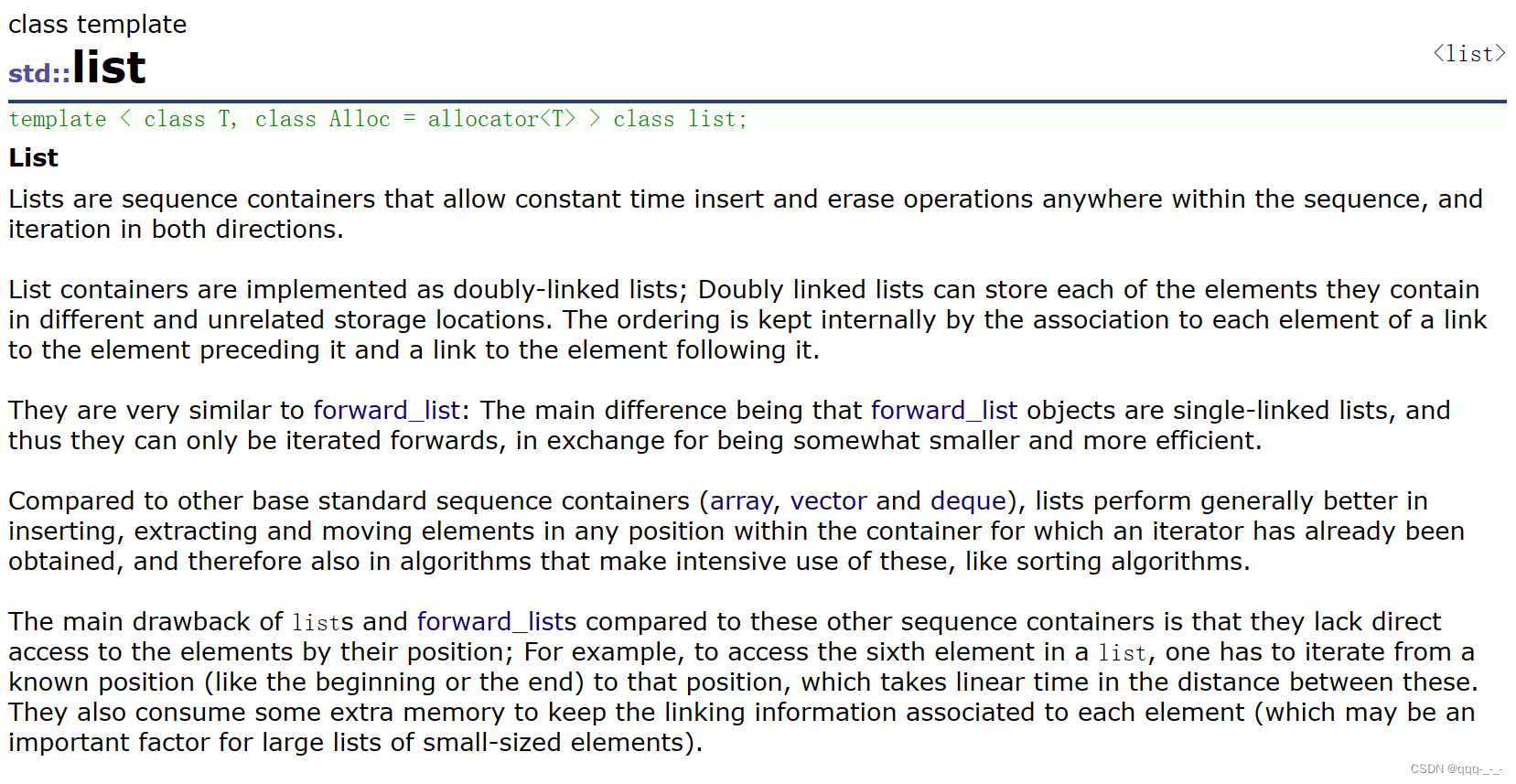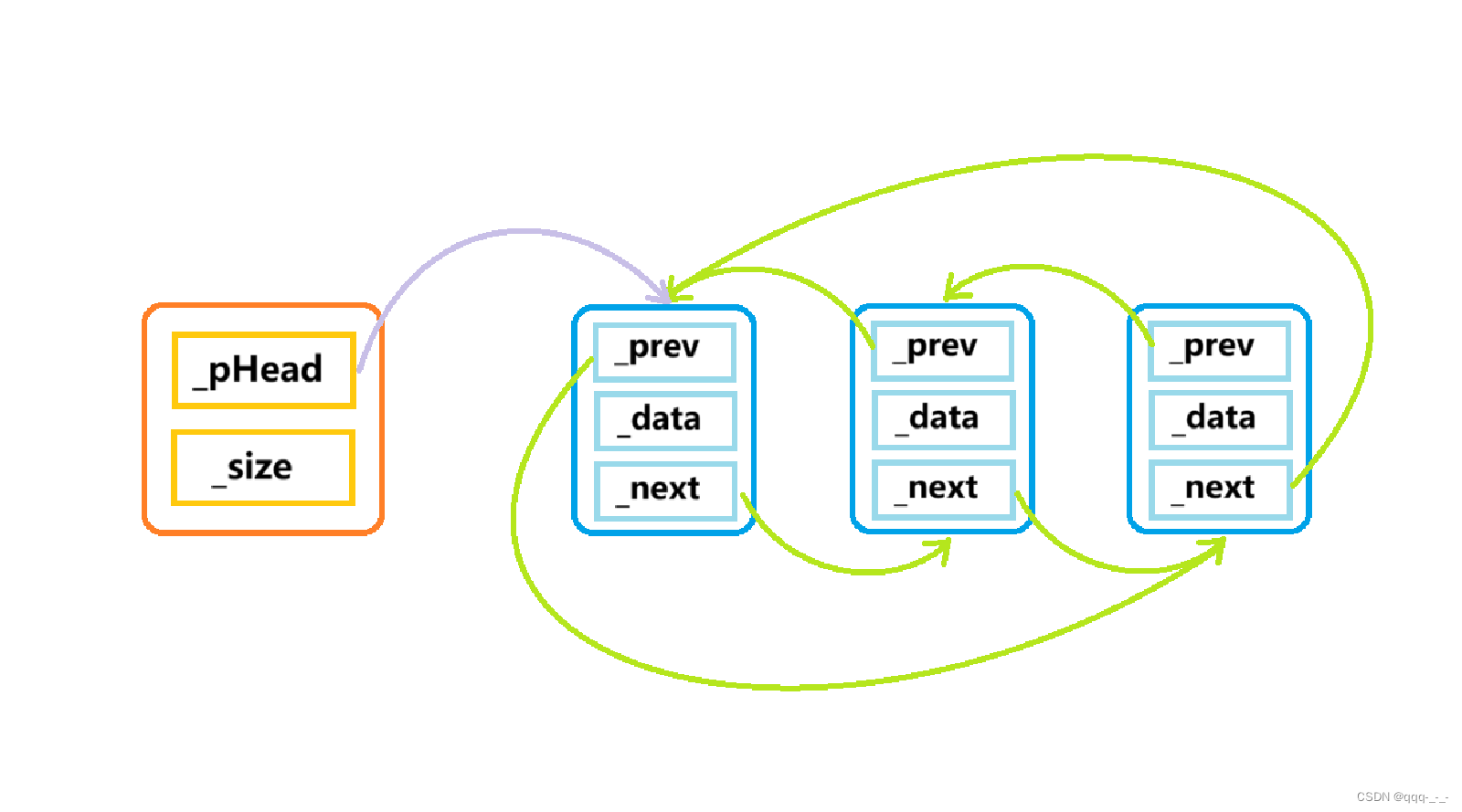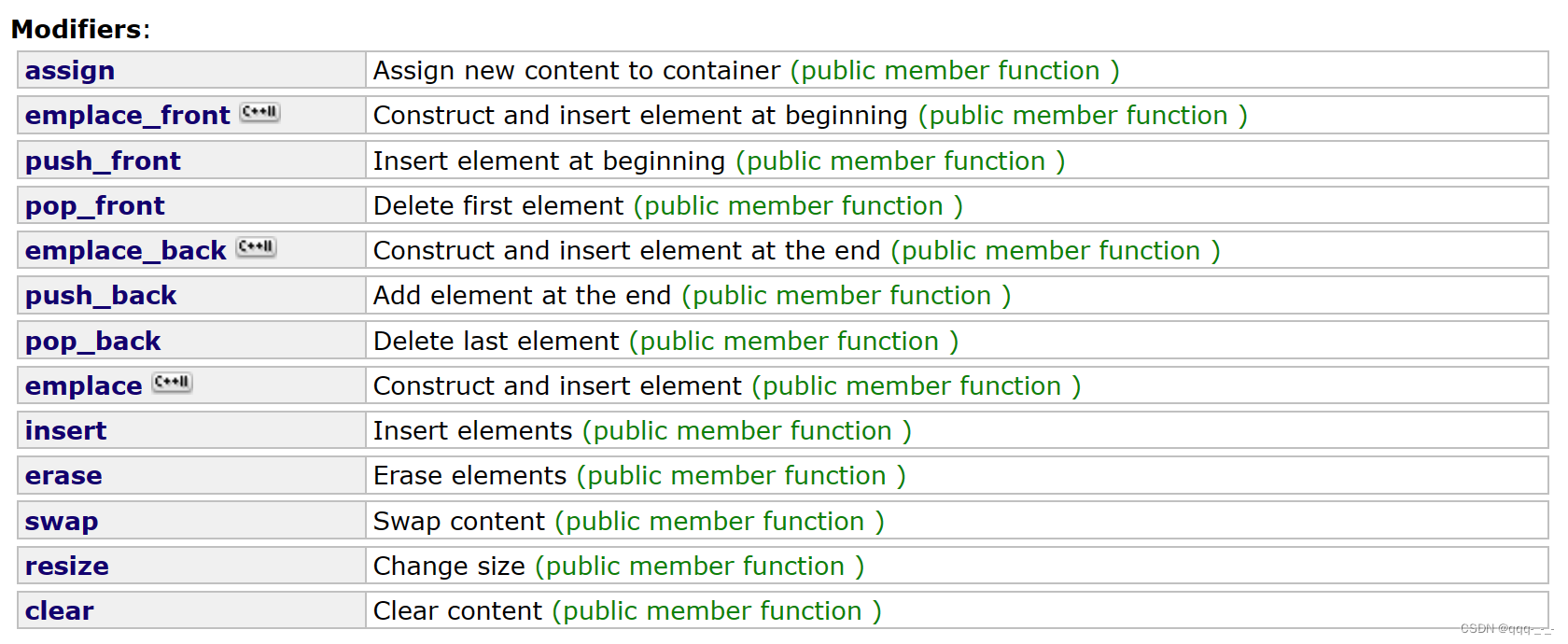模拟实现list
- 引言(实现概述)
- list迭代器实现
- 默认成员函数
- operator* 与 operator->
- operator++ 与 operator--
- operator== 与 operator!=
- 迭代器实现概览
- list主要接口实现
- 默认成员函数
- 构造函数
- 析构函数
- 赋值重载
- 迭代器
- 容量
- 元素访问
- 数据修改
- insert
- erase
- push_back 与 push_front
- pop_back 与 pop_front
- clear
- swap
- 源码概览
- 总结
引言(实现概述)
在前面,我们介绍了list的使用:
戳我看list的介绍与使用详解哦
在本篇文章中将重点介绍list的接口实现,通过模拟实现可以更深入的理解与使用list

我们模拟实现的 list 底层是一个带头双向循环链表
在实现list时,我们首先需要一个结构体以表示链表中结点的结构list_node,大致包括数据与指向前后结点的指针:
template<class T>
struct list_node //结点类
{list_node<T>* _prev;list_node<T>* _next;T _date;list_node(const T& date = T()) //匿名对象: _prev(nullptr), _next(nullptr), _date(date){}
};
在有了结点之后,还需要一个 list类,包括双向链表的头结点指针_pHead,链表中的元素个数_size:
template<class T>
class list //带头双向循环链表
{typedef list_node<T> Node;
private:Node* _pHead;size_t _size;
};
大致结构如下:

关于带头双向循环链表的实现可以参考之前的C语言版本实现,在本篇文章中结构将不是最重点的内容:戳我看C语言实现带头双向循环链表详解哦
与vector相同,list是一个类模板,其声明与定义不能分离。我们将模拟实现的list放在我们创建的命名空间内,以防止与库发生命名冲突。
在list的模拟实现中,我们只实现一些主要的接口,包括默认成员函数、迭代器、容量、元素访问与数据修改:
list迭代器实现
与vector不同,list的迭代器是指针的封装,通过运算符重载来实现原生指针的功能。
我们可以通过封装结点的指针,即list_node<T>*,来实现迭代器:
默认成员函数
对于默认成员函数,其实我们只需要实现构造函数即可,这个__list_iterator类的属性只有一个结构体指针,并不存在类中申请的资源,所以编译器生成的析构函数与赋值运算符重载就够用了,不需要再实现了。
- 默认构造
对于默认构造函数,我们可以使用缺省参数,即参数类型为结构体指针,缺省值为nullptr。
直接在初始化列表中用参数初始化类属性即可:
__list_iterator(Node* pNode = nullptr):_pNode(pNode){}
- 拷贝构造
对于拷贝构造,参数必须是类类型的引用,可以加上const修饰(我们可以在类中将类类型__list_iterator<T, Ref, Ptr>重命名为self,以方便书写)
在函数中直接赋值即可:
__list_iterator(const self& it){_pNode = it._pNode;}
operator* 与 operator->
迭代器使用时应该是与指针基本类似的,所以也需要重载*与->。
- 重载
*
指针当然可以进行解引用的操作,指向容器中元素的指针。对这个指针进行解引用操作结果就应该是该指针指向的元素。对于list的迭代器而言,解引用该迭代器的结果就应该是结点中的_data元素的引用,类型为&T:
(我们可以为模板参数加上一个参数,即Ref,它表示T&)
Ref operator*(){return _pNode->_date;}
- 重载
->
当T是自定义类型时,其指针还可以通过->直接访问到T类型对象_data中的元素,起指针作用的迭代器自然也需要实现这个功能。
但是对于这个运算符重载而言,它并不知道要返回T类型对象中的什么元素,所以这个operator->函数可以直接返回该迭代器对应的结点中的_data元素的指针,然后在调用的时候再通过->来访问其中元素:it->->a;(通过迭代器it访问T类型对象中的a元素)。
但是,这样的形式访问又与指针的用法不一致,所以这里有一个特殊的规定,即规定需要使用it->a;的方式通过迭代器访问T类型对象中的元素,以获得与原生指针相同的使用方式:
(我们可以为模板参数加上一个参数,即Ptr,它表示T*)
Ptr operator->(){return &(_pNode->_date);}
operator++ 与 operator–
- 重载
++
++操作即实现迭代器的指向向后移动一个元素,list的迭代器底层是一个结构体指针,所以只需要将当前_pNode->_next赋值给_pNode即可
且++分为前置++与后置++,在区别这两个的实现时,前面类和对象时已经详细介绍过了,即给后置++增加一个参数int,但是不传参,只用于区分前置与后置。
另外后置++需要创建临时对象,在*this++后必须要返回临时对象而非引用:
self& operator++(){_pNode = _pNode->_next;return *this;}self operator++(int){self temp(*this);_pNode = _pNode->_next;return temp;}
- 重载
--
重载--与前面的++类似,即将_pNode->_prev赋值给_pNode即可:
self& operator--(){_pNode = _pNode->_prev;return *this;}self operator--(int){self temp(*this);_pNode = _pNode->_prev;return temp;}
operator== 与 operator!=
对于==与!= 重载,即判断两个迭代器对象的属性是否相等即可:
bool operator==(const self& it){return _pNode == it._pNode;}bool operator!=(const self& it){return _pNode != it._pNode;}
迭代器实现概览
template<class T, class Ref, class Ptr>struct __list_iterator{typedef list_node<T> Node;typedef __list_iterator<T, Ref, Ptr> self;Node* _pNode;__list_iterator(Node* pNode = nullptr):_pNode(pNode){}__list_iterator(const self& it){_pNode = it._pNode;}Ref operator*(){return _pNode->_date;}Ptr operator->(){return &(_pNode->_date);}self& operator++(){_pNode = _pNode->_next;return *this;}self operator++(int){self temp(*this);_pNode = _pNode->_next;return temp;}self& operator--(){_pNode = _pNode->_prev;return *this;}self operator--(int){self temp(*this);_pNode = _pNode->_prev;return temp;}bool operator==(const self& it){return _pNode == it._pNode;}bool operator!=(const self& it){return _pNode != it._pNode;}};
list主要接口实现
在实现list之前,我们可以对一些较为麻烦的类型进行重命名以方便书写:
typedef list_node<T> Node;
typedef __list_iterator<T, T&, T*> iterator;
typedef __list_iterator<T, const T&, const T*> const_iterator;
默认成员函数
构造函数
实现构造函数时,我们需要实现无参构造、n个指定元素构造、迭代器区间构造以及拷贝构造:
无参构造:
由于我们模拟实现的list底层为带头双向循环链表,所以在无参构造时虽然没有在list中放入元素,但是还使需要先放入一个空结点作为头节点。
创建头节点的操作在任何构造函数中都要先进行,所以我们将其封装为一个init_empty_list函数。这个初始化空list的函数需要new一个结点,然后使节点中的_prev与_next都指向它自身,最后将_size赋值为0:
void init_empty_list(){ _pHead = new Node();_pHead->_prev = _pHead;_pHead->_next = _pHead;_size = 0;}list(){init_empty_list();}
n个指定元素构造:
使用n个指定元素构造有两个参数,第一个就是int,第二个是const T&,缺省值为T()
函数中,首先调用init_empty_list构建一个头结点;
再循环,使用push_bake尾插n个指定元素value即可(push_back后面会实现):
list(int n, const T& value = T()){init_empty_list();while (n--){push_back(value);}}
迭代器区间构造:
是用迭代器区间构造函数是一个函数模板,可以使用任何容器的迭代器区间来构造list
函数中,首先调用init_empty_list构建一个头结点;
然后再循环,使用push_bake尾插first迭代器的解引用出的元素,当first与last相等时出循环:
template <class Iterator>list(Iterator first, Iterator last){init_empty_list();while (first != last){push_back(*first);++first;}}
拷贝构造:
拷贝构造函数的参数是一个const list<T>&
实现时,首先调用init_empty_list构建一个头结点;
然后范围for,使用push_bake将l中的元素逐一尾插到list中:
list(const list<T>& l){init_empty_list();for (auto el : l){push_back(el);}}
析构函数
析构函数需要实现释放list中的资源。
首先复用clear,清空list中的元素。clear中会实现释放结点中的资源,后面部分会实现;
再delete _pHead;,释放头节点中的资源,它会调用结点结构体的析构函数:
~list(){clear();delete _pHead;}
赋值重载
对于赋值运算符重载,我们直接使用新写法,即先使用参数l创建一个临时对象;
然后使用swap将临时对象与*this交换(后面会实现swap函数);
最后返回*this即可,创建的临时对象就会在函数栈帧销毁时自动释放:
list<T>& operator=(const list<T>& l) //list& operator=(const list l) 对于赋值重载,这样也可{list<T> temp(l);swap(temp);return *this;}
迭代器
在前面已经实现了list的迭代器,它是结点指针的封装;
这里暂时只实现begin与end,关于反向迭代器的实现在后面会详细介绍。
begin返回首元素的地址,即头结点的下一个结点的地址;
end返回尾元素下一个位置的地址,即头节点的地址,他们分别重载有const版本:
iterator begin(){return iterator(_pHead->_next);}iterator end(){return iterator(_pHead);}const_iterator begin() const{return const_iterator(_pHead->_next);}const_iterator end() const{return const_iterator(_pHead);}
容量
在容器部分,由于list并没有容量的概念,所以我们只需要实现size与empty即可;

我们在list的属性中,我们设置了_size,在插入元素时_size++,删除元素时_size--,所以这里只需要返回_size的值即可;
当_size == 0时,list为空,empty返回true,否者返回false:
size_t size() const{return _size;}bool empty() const{if (_size == 0)return true;elsereturn false;}
元素访问
由于list在任意位置访问元素的成本较高,就没有提供operator[]的接口,所以我们只需要实现front与back即可。分别返回首尾的元素,有普通对象与const对象两个重载版本:

在实现时,我们可以借助list的属性_pHead,即头结点的指针来访问首尾元素:
我们模拟实现list的底层是带头双向循环链表,所以list中的第一个元素就是_pHead->_next指向的结点中的元素;list中的_pHead->_prev指向的结点中的元素:
front只需要返回 _pHead->_next->_date 即可;
back返回_pHead->_prev->_date即可,返回值类型为T&,const版本就返回const T&即可:
T& front(){return _pHead->_next->_date;}const T& front()const{return _pHead->_next->_date;}T& back(){return _pHead->_prev->_date;}const T& back()const{return _pHead->_prev->_date;}
数据修改

insert
list 的结构使在任意位置插入数据的效率是较高的,只需要创建结点,再链接到pos位置前即可:
在实现insert时,首先new一个结点,类型为Node,并用val初始化(这个Node类型是前面重命名后的类型);
这时我们需要记录pos位置的结点指针为cur,pos位置前面的结点指针为prev,以方便后续链接;
然后将pos结点的前一个结点与新结点链接,即newnode与prev链接;
再将pos结点与新结点链接,即newnode与cur链接;
最后,更新_size,并返回新结点的迭代器:
// 在pos位置前插入值为val的节点iterator insert(iterator pos, const T& val){Node* newnode = new Node(val);Node* cur = pos._pNode;Node* prev = cur->_prev;newnode->_prev = prev;prev->_next = newnode;newnode->_next = cur;cur->_prev = newnode;++_size;return iterator(newnode);}
erase
erase实现时,只需要释放pos位置的结点,并链接剩余的结点即可:
首先assert判断list是否为空;
这时我们需要记录pos位置的结点指针为cur,pos位置前面的结点指针为prev,pos的后一个结点指针为next,以方便后续链接;
然后直接链接pos位置的前一个结点与后一个结点,即链接prev与next即可;
最后,释放cur指向的结点,更新_size,并返回next:
// 删除pos位置的节点,返回该节点的下一个位置iterator erase(iterator pos){assert(!empty());Node* cur = pos._pNode;Node* prev = cur->_prev;Node* next = cur->_next;prev->_next = next;next->_prev = prev;delete cur;--_size;return iterator(next);}
push_back 与 push_front
对于头插与尾插的实现,复用insert即可:
push_front,即在首结点的前面一个位置插入一个元素,即在begin()迭代器位置插入;
push_back,即在尾结点的后一个位置插入一个元素,即在end()位置插入:
void push_back(const T& val){insert(end(), val);}void push_front(const T& val){insert(begin(), val);}
pop_back 与 pop_front
对于头删尾删的实现,复用erase即可:
pop_front,即删除头节点,即 erase删除begin()位置的结点 即可;
pop_back,删除尾结点,即 erase删除end()前面一个结点即可,但是由于list迭代器不支持-操作,所以这里传参为--end():
void pop_front(){erase(begin());}void pop_back(){erase(--end());}
clear
clear用于清理list中的所有元素,可以直接复用erase来实现清理:
我们可以通过遍历迭代器的方式逐一释放结点:
令it的初始值为begin(),循环逐一erase删除,当it等于end()的时候终止循环,就可以实现删除所有结点并保留头节点;
另外,由于erase删除某节点后,会返回删除节点的下一个位置,所以只要把返回值载赋值给it就实现了迭代器的向后移动:
void clear(){iterator it = begin();while (it != end()){it = erase(it);//erase返回删除的结点的下一个位置的迭代器}}
swap
实现list的交换函数时,只需要使用库swap交换list的属性即可,即交换_pHead与_size:
void swap(list<T>& l){std::swap(_pHead, l._pHead);std::swap(_size, l._size);}
源码概览
(关于反向迭代器的实现在后面会详细介绍,现在可以暂时忽略)
#include<iostream>
#include<cassert>
#include"my_reverse_iterator.h"namespace qqq
{template<class T>struct list_node{list_node<T>* _prev;list_node<T>* _next;T _date;list_node(const T& date = T()) //匿名对象: _prev(nullptr), _next(nullptr), _date(date){}};template<class T, class Ref, class Ptr>struct __list_iterator{typedef list_node<T> Node;typedef __list_iterator<T, Ref, Ptr> self;Node* _pNode;__list_iterator(Node* pNode = nullptr):_pNode(pNode){}__list_iterator(const self& it){_pNode = it._pNode;}Ref operator*(){return _pNode->_date;}Ptr operator->(){return &(_pNode->_date);}self& operator++(){_pNode = _pNode->_next;return *this;}self operator++(int){self temp(*this);_pNode = _pNode->_next;return temp;}self& operator--(){_pNode = _pNode->_prev;return *this;}self operator--(int){self temp(*this);_pNode = _pNode->_prev;return temp;}bool operator==(const self& it){return _pNode == it._pNode;}bool operator!=(const self& it){return _pNode != it._pNode;}};template<class T>class list //带头双向循环链表{typedef list_node<T> Node;public:typedef __list_iterator<T, T&, T*> iterator;typedef __list_iterator<T, const T&, const T*> const_iterator;typedef ReverseIterator<iterator, T&, T*> reverse_iterator;typedef ReverseIterator<const_iterator, const T&, const T*> const_reverse_iterator;public:/ constructor and destructor void init_empty_list(){ _pHead = new Node();_pHead->_prev = _pHead;_pHead->_next = _pHead;_size = 0;}list(){init_empty_list();}list(int n, const T& value = T()){init_empty_list();while (n--){push_back(value);}}template <class Iterator>list(Iterator first, Iterator last){init_empty_list();while (first != last){push_back(*first);++first;}}list(const list<T>& l){init_empty_list();for (auto el : l){push_back(el);}}list<T>& operator=(const list<T>& l) //list& operator=(const list l) 对于赋值重载,这样也可{list<T> temp(l);swap(temp);return *this;}~list(){clear();delete _pHead;}// List Iterator///iterator begin(){return iterator(_pHead->_next);}iterator end(){return iterator(_pHead);}const_iterator begin() const{return const_iterator(_pHead->_next);}const_iterator end() const{return const_iterator(_pHead);}reverse_iterator rbegin(){return reverse_iterator(end());}reverse_iterator rend(){return reverse_iterator(begin());}/List Capacity//size_t size() const{return _size;}bool empty() const{if (_size == 0)return true;elsereturn false;}///List Access///T& front(){return _pHead->_next->_date;}const T& front()const{return _pHead->_next->_date;}T& back(){return _pHead->_prev->_date;}const T& back()const{return _pHead->_prev->_date;}List Modify//void push_back(const T& val){insert(end(), val);}void pop_back(){erase(--end());}void push_front(const T& val){insert(begin(), val);}void pop_front(){erase(begin());}// 在pos位置前插入值为val的节点iterator insert(iterator pos, const T& val){Node* newnode = new Node(val);Node* cur = pos._pNode;Node* prev = cur->_prev;newnode->_prev = prev;prev->_next = newnode;newnode->_next = cur;cur->_prev = newnode;++_size;return iterator(newnode);}// 删除pos位置的节点,返回该节点的下一个位置iterator erase(iterator pos){assert(!empty());Node* cur = pos._pNode;Node* prev = cur->_prev;Node* next = cur->_next;prev->_next = next;next->_prev = prev;delete cur;--_size;return iterator(next);}void clear(){iterator it = begin();while (it != end()){it = erase(it);//erase返回删除的结点的下一个位置的迭代器}}void swap(list<T>& l){std::swap(_pHead, l._pHead);std::swap(_size, l._size);}private:Node* _pHead;size_t _size;};
};
总结
到此,关于list的模拟实现就到此结束了
模拟实现容器并不是为了造一个更好的轮子,而是为了更好的理解与使用容器
如果大家认为我对某一部分没有介绍清楚或者某一部分出了问题,欢迎大家在评论区提出
如果本文对你有帮助,希望一键三连哦
希望与大家共同进步哦






软件设计)



![二、[mysql]之Explain讲解与实战](http://pic.xiahunao.cn/二、[mysql]之Explain讲解与实战)


、路由重定向、页面未找到的提示页面404、vue路由模式设置)




)
